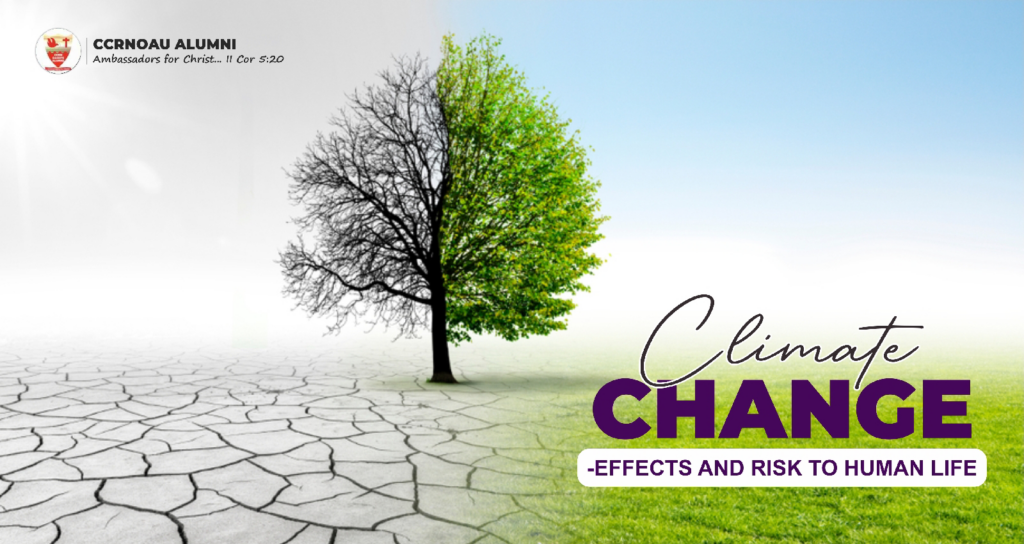
Climate is the average weather conditions in each location over a long period of time. One can therefore say that climate describes the amount of rainfall and the period of the year when it rains, the temperatures within a given period, and the level of sunshine of a geographical location. A deep understanding of the climatic conditions of a place can make one predict accurately, the weather conditions at specific times of the year. The susceptibility of the environment to the actions and activities of human beings coupled with other factors has ensured that elements of changes are introduced to the already established climatic conditions we have come to know.
Climate change is any systematic changes in climatic variables due to external natural factors or human activities. Therefore, when temperature violates the already established standard for a particular place or when there is an abnormality in the amount of rainfall or an extension in the duration of the rainy season, all these point to changes in the climatic conditions. According to World Meteorological Association, it takes a classical time span of 30 years for changes in the aforesaid metrics to be considered as climate change.
Climate changes are not just due to human actions but also due to natural external forces. However, global human activities are the major contributors to the changes we now experience in the climatic conditions. To put this into a better perspective, since the industrial revolution and subsequent introduction of heavy machinery for industrial processes, activities of humans that release large amounts of carbon dioxide and other greenhouse gases into the atmosphere have increased thereby leading to more changes In the climate. In comparison, natural processes such as changes in the energy of the sun and volcanic eruptions also affects the earth’s climate howbeit these natural changes cannot account for the global warming we now experience. Thus, we can conclude that human activities have contributed substantially to climate changes over the years while the effects of the natural factors can be considered negligible.
Of the human activities affecting climate, chief among them is emission of greenhouse gases through the burning of fossil fuels such as coal, oil and gas. Since the industrial revolution, there has been an increase in the use of fossil fuel to generate energy; this has consequently led to the increase in the concentrations of greenhouse gases in the atmosphere. The greenhouse gases – carbon dioxide, carbon monoxide, nitrous oxide and methane – have varying degrees of effects on the environment resulting in climate changes through the greenhouse effect – a process that occurs when energy from the sun goes through the atmosphere and becomes trapped within the atmosphere to keep the earth warm. – At normal concentrations, the greenhouse gases are responsible for absorbing energy from the atmosphere. They act like ‘blanket’ covering making the earth warmer. This process on its own is important for life support on earth but when there is a very high concentration of these gases in the atmosphere, there is an over-retention of heat energy in the atmosphere resulting in changes in the earth’s climate.
Another factor that contributes greatly to climate change is the human activities as related to deforestation and intensive agriculture. Trees absorb carbon dioxide, cutting down of trees through deforestation will lead to a tremendous increase in the concentrations of CO2 gas in the atmosphere. As revealed earlier, large volumes of the gas in the atmosphere leads to over retention of heat in the atmosphere leading to global warming. Practicing of intensive agriculture opens ways of increasing the proportions of greenhouse gases in the atmosphere since plants emit greenhouse gases like methane and nitrous oxide.
Warmer temperatures caused by the greenhouse effect are changing the established weather patterns and disrupting the already known natural balance. These changes and disruptions pose many great risks to humans, animals, plants and the environment at large.
One of the foremost consequences of climate change is the experience of unusually high temperatures closer to the earth. Nearly all land areas are experiencing extremely hot days and heat waves. The immediate consequence of this high temperature is the increase in heat-related sicknesses and the spontaneous eruptions and spread of wildfires. Hot temperatures make it very difficult to work and move around. Global warming causes changes in rainfall which consequently leads to more severe and frequent storms. There is the danger of flooding and destruction of homes. Climate change has ensured scarcity of water in many regions of the earth. Droughts ensuing from water scarcity has the capacity to stir very destructive sand and dust storms across many regions; this encourages desert encroachment with an accompanying characteristic reduction in lands for growing foods. If lands are not available for growing and water is not available for plant’s growth, there is a going to be large scale reduction in food production which can be the starting point for global food crisis.
The animals are not left out in the experiencing the adverse effects of climate change. While some species may be able to relocate to other areas for survival, some may not be able to survive and adapt to the changes in the climatic conditions of their natural habitat. This could lead to loss of some species and temporary or permanent displacement of animals from their habitat. It should also be pointed out that changing weather patterns are encouraging rapid spread of diseases; people are at a higher risk of contracting different forms of diseases.
The effects of climate changes are limitless; however, we can reduce the inherent risks if we become very intentional about protecting our environment by our actions and choices. It is advisable to switch either partially or totally to the use of renewable sources for power generation. This will drastically reduce greenhouse emissions to the barest minimum. We must embrace the practice of reuse, repair and recycle in ensuring that we protect the environment from emissions. Efforts should be made to eat more fruits and vegetables; this does not only strengthen our immune system; it also planting more of fruits and vegetables which emits very low concentrations of greenhouse gases.
In all, we must be aware of our actions as it relates to the environment. At all times, we should remember that protecting the environment is a collective responsibility as it is a personal one.
Leave your comments and share with someone. Shalom.
By Bro. Ike Damian
